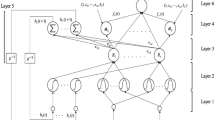Abstract
This study presents a recurrent wavelet-based neuro-fuzzy network with dynamic symbiotic evolution (RWNFN-DSE) for dynamic system processing. The proposed RWNFN-DSE model combines the traditional Takagi-Sugeno-Kang (TSK) fuzzy model and the wavelet neural networks (WNN). This study adopts the non-orthogonal and compactly supported functions as wavelet neural network bases. Temporal relations embedded in the network are caused by adding some feedback connections representing the memory units into the second layer. A novel evolution learning called dynamic symbiotic evolution (DSE) is used to tune the parameter of the RWNFN-DSE model. The better chromosomes will be initially generated while the better mutation points will be determined for performing dynamic-mutation. Simulation results have shown that the proposed RWNFN-DSE model obtain better performance than other existing models.
Similar content being viewed by others
References
Lin CT, Lee CSG (1996) Neural fuzzy systems: a neuro-fuzzy synergism to intelligent system. Prentice-Hall, New Jersey
Towell GG, Shavlik JW (1993) Extracting refined rules from knowledge-based neural networks. Mach Learn 13:71–101
Lin CJ, Lin CT (1997) An ART-based fuzzy adaptive learning control network. IEEE Trans Fuzzy Systs 5(4):477–496
Wang LX, Mendel JM (1992) Generating fuzzy rules by learning from examples. IEEE Trans Syst Man Cybern 22(6):1414–1427
Takagi T, Sugeno M (1985) Fuzzy identification of systems and its applications to modeling and control. IEEE Trans Syst Man Cybern SMC-15:116–132
Jang J-SR (1993) ANFIS: Adaptive-network-based fuzzy inference system. IEEE Trans on Syst Man Cybern 23:665–685
Juang CF, Lin CT (1998) An on-line self-constructing neural fuzzy inference network and its applications. IEEE Trans Fuzzy Systs 6(1):12–31
Lin FJ, Lin CH, Shen PH (2001) Self-constructing fuzzy neural network speed controller for permanent-magnet synchronous motor drive. IEEE Trans Fuzzy Systs 9(5):751–759
Takagi H, Suzuki N, Koda T, Kojima Y (1992) Neural networks designed on approximate reasoning architecture and their application. IEEE Trans Neural Netw 3(5):752–759
Mizutani E, Jang J-SR (1995) Coactive neural fuzzy modeling. Proc Int Conf Neural Netw 760–765
Lin CJ, Chin CC (2003) A wavelet-based neuro-fuzzy system and its applications. In: Proceedings of IEEE international conference neural networks, Oregon, July 20–24, pp 1921–1926
Narendra KS, Parthasarathy K (1990) Identification and control of dynamical systems using neural networks. IEEE Trans Neural Netw 1:4–27
Elman JL (1990) Finding structure in time. Cognit Sci 14:179–211
Zhang J, Morris AJ (1999) Recurrent neuro-fuzzy networks for nonlinear process modeling. IEEE Trans Neural Netw 10(2):313–326
Juang CF, Lin CT (1999) A recurrent self-organizing neural fuzzy inference network. IEEE Trans Neural Netw 10(4):828–845
Lee CH, Teng CC (2000) Identification and control of dynamic systems using recurrent fuzzy neural networks. IEEE Trans Fuzzy Systs 8(4):349–366
Mastorocostas PA, Theocharis JB (2002) A recurrent fuzzy-neural model for dynamic system identification. IEEE Trans Syst Man Cybern 32(2):176–190
Su SF, Yang FY (2002) On the dynamical modeling with neural fuzzy networks. IEEE Trans Neural Networks 13(6):1548–1553
Mouzouris G, Mendel JM (1997) Dynamic non-singleton fuzzy logic systems for nonlinear modeling. IEEE Trans Fuzzy Systs 5:199–208
Juang CF (2002) A TSK-type recurrent fuzzy network for dynamic systems processing by neural network and genetic algorithms,. IEEE Trans Fuzzy Systs 10(2):155–170
Karr CL (1991) Design of an adaptive fuzzy logic controller using a genetic algorithm. In: Proceedings 4th conference genetic algorithms, pp 450–457
Homaifar A, McCormick E (1995) Simultaneous design of membership functions and rule sets for fuzzy controllers using genetic algorithms. IEEE Trans Fuzzy Syst 3(9):129–139
Lee MA, Takagi H (1993) Integrating design stages of fuzzy systems using genetic algorithms. In: Proceedings of IEEE International conference on fuzzy Systems, New York, 1:612–617
Ho DWC, Zhang PA, Xu J (2001) Fuzzy wavelet networks for function learning. IEEE Trans Fuzzy Systs 9(1):200–211
Moriarty DE, Miikkulainen R (1996) Efficient reinforcement learning through symbiotic evolution. Mach Learn 22:11–32
Juang CF, Lin JY, Lin CT (2000) Genetic reinforcement learning through symbiotic evolution for fuzzy controller design. IEEE Trans Syst Man Cybern Part B 30(2):290–302
Jang J-SR, Sun CT, Mizutani E (1997) Neuro-fuzzy and soft computing. Ch 17, Prentice-Hall New Jersey
Cordon O, Herrera F, Hoffmann F, Magdalena L (2001) Genetic fuzzy systems evolutionary tuning and learning of fuzzy knowledge bases. Advances in fuzzy systems-applications and theory, vol 19, World Scientific Publishing, New Jersey
Williams RJ, Zipser D (1989) A learning algorithm for continually running recurrent neural networks. Neural Comput 1(2):270–280
Sastry PS, Santharam G, Unnikrishnan KP (1994) Memory neural networks for identification and control of dynamic systems. IEEE Trans Neural Netw 5:306–319
Author information
Authors and Affiliations
Corresponding author
Rights and permissions
About this article
Cite this article
Lin, CJ., Xu, YJ. A novel evolution learning for recurrent wavelet-based neuro-fuzzy networks. Soft Comput 10, 193–205 (2006). https://doi.org/10.1007/s00500-004-0455-7
Published:
Issue Date:
DOI: https://doi.org/10.1007/s00500-004-0455-7




